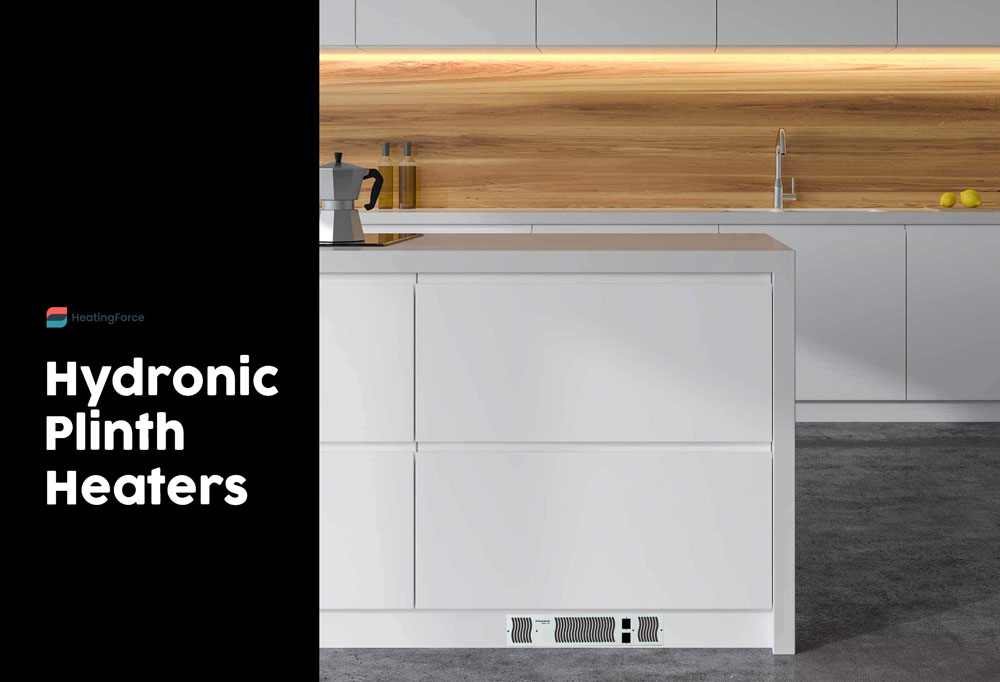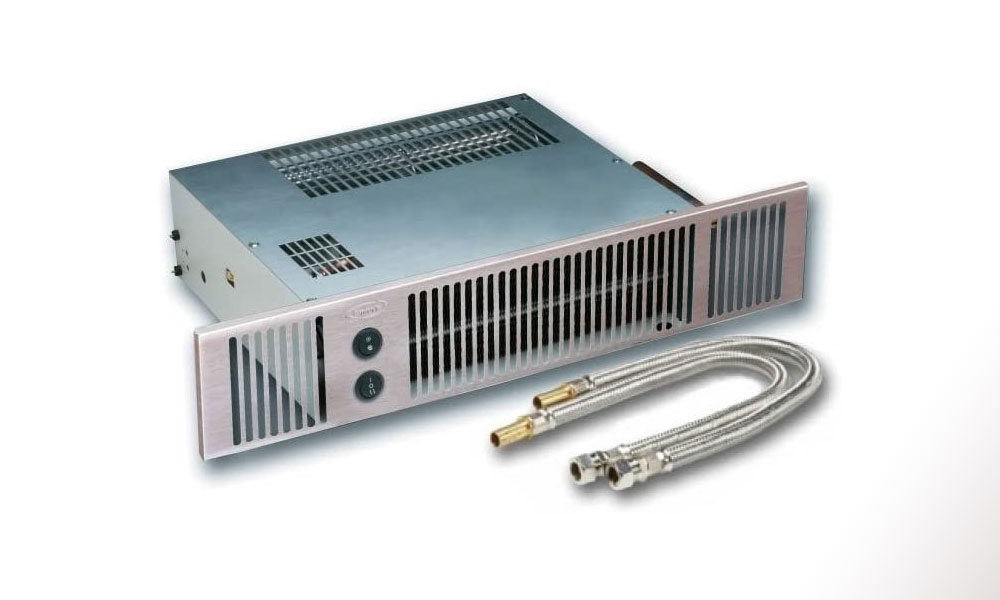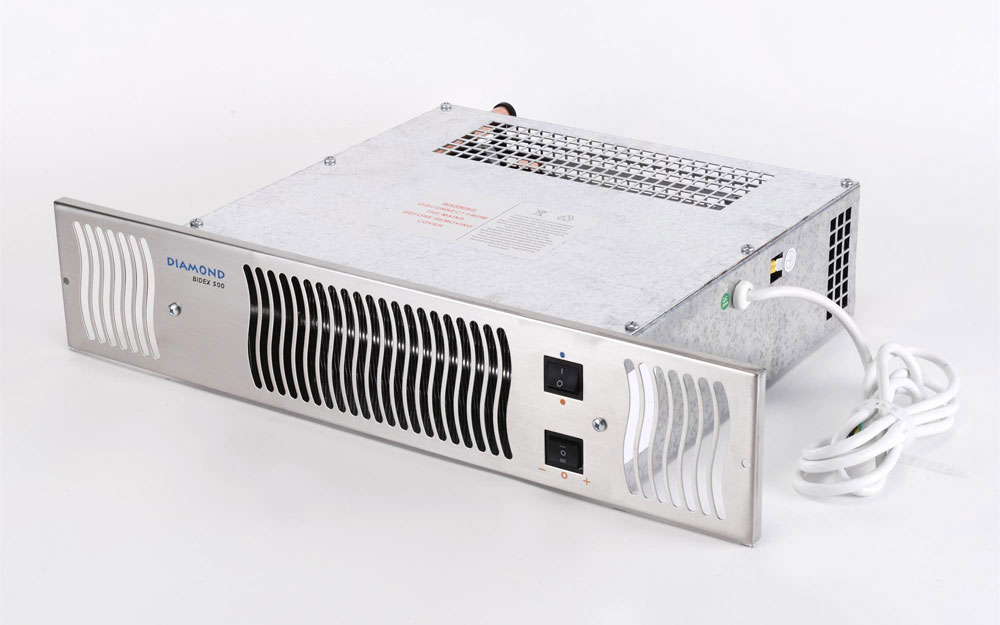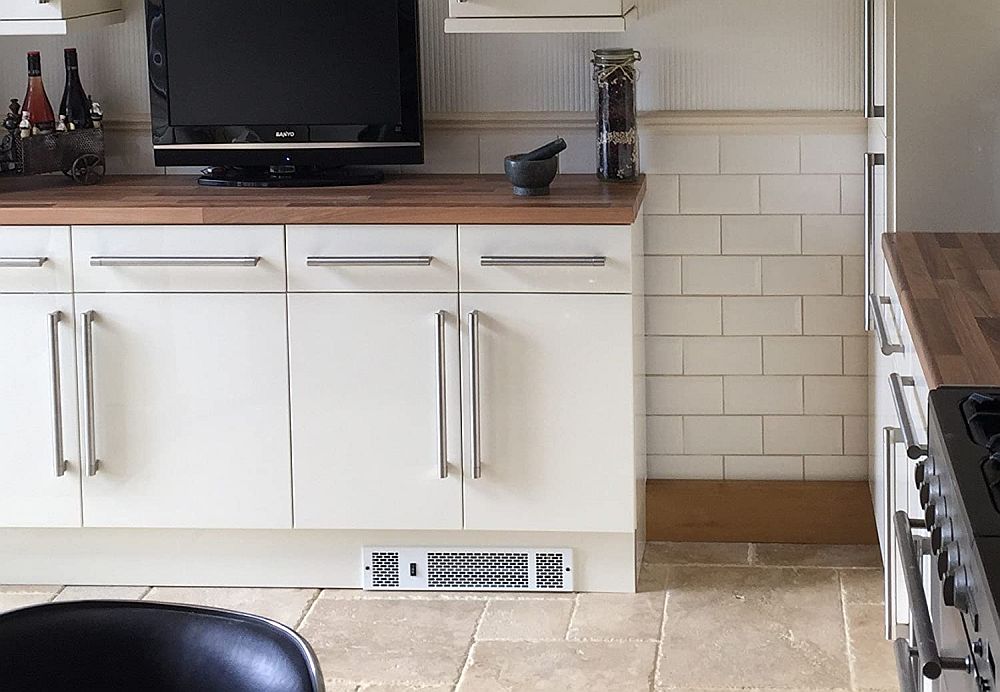Best Hydronic Plinth Heater For Fancy, Cozy Kitchens
If you’re tired of that old panel radiator taking up space or lugging a plug-in electric radiator into the kitchen, you need a hydronic plinth heater in your life.
But what exactly are they, and is it worth making the switch? We address these and other questions below.

What is a plinth heater?
In order to answer this question, it helps to first envision the cabinetry in your kitchen. Look at those lovely doors protecting your dishes within, then look directly below. See that bit of baseboard running the length of your cupboard? That’s the plinth.
Now, mentally cut a hold in that plinth, and add an appropriately box-shaped heater, and that’s a plinth heater! Of course, such a device needs to be purpose-built for that particular position within the home, so not just any square-ish radiator will do.
Best hydronic plinth heater
Central heating plinth heaters may be a bit of a niche product, but you’re spoilt for choice when it comes to the range of quality products currently available on the market.
Here below, we present the three best hydronic plinth heaters (all manufactured in the UK), and any of which will prove a wonderful upgrade to your home or office.
1. Thermix KPH-1500
Of the three products we’re reviewing today, Thermix’s KPH-1500 is our favourite in terms of aesthetics. It features a simple, brick-wall style grille pattern, making for an attractive yet understated fascia that works in any room of the house.

The only adornment is a single mode switch, which you can use to toggle between the two heat modes (standard, and boosted), as well as to shut the device off entirely. While you may wish for neon power indicator, keep in mind that a hydronic plinth heater like the KPH-1500 never overheats or gets hot to the touch.
Mechanically simple with virtually no maintenance required, the KPH-1500 makes for a sound investment in the comfort of your home or office. So long as you hired professional installation, you can count on your plinth heater to do its job as a natural extension of your central heating system.
Thermix offers an incredible guarantee on parts and labour up to 2 years, though they don’t cover against faulty installation or misuse. Keep your technician installation receipt to hand, though, and you’ll be fine.
KPH-1500 key figures:
- Heat output: 1260W or ~4300BTU/hr; 1450W or ~4950BTU/hr
- Dimensions: 50 x 10.5 x 29cm
- Styles: Silver, Black, White, Brushed Stainless
- Warranty: 2 years
Final thoughts on the Thermix central heating plinth heater
It’s less and less common to be able to buy domestic UK-made electronics, but Thermix has made this a reality and delivered on the promise of higher quality. Well-built, maintenance-free and easy to install, you’ll find the most notable thing about the KPH-1500 in practice is how it does its job quietly and dutifully.
As an extension of your central heating system, efficiency is somewhat dictated by the quality of your combi boiler or heat pump. But generally, you can expect the KPH-1500 to consume about 10p per week with daily usage.
Overall, if you’re looking to heat a space around 30m3, the Thermix KPH-1500 is an attractive, efficient pick.
2. Bidex Diamond 500 hydronic plinth heater
Manufactured in the UK, the Diamond 500 central heating plinth heater is proof Bidex knows how to please the domestic market. Once again, we have an attractive grille pattern design which comes in white by default (though you can buy replacements from Bidex in three additional colours).

This time, the fascia features two switches instead of one. The bottom-most of these controls the fan speed: normal, boosted, and off. Having multiple heat output settings is obviously a plus for when the temperatures really start to drop; though it’s also nice in giving you some flexibility into which size room you may fit your new plinth heater.
The switch above that one is a real crowd-pleaser, allowing you to toggle “Summer” and “Winter” modes. Yes, Winter mode sounds redundant in a heater, as producing warmth is what you’ve bought it for in the first place.
In Summer mode, however, your heater puts down the metaphorical top and converts into a two-speed cool-blowing fan. If you’ve got a part of the house underserved by your aircon, this can be a real life-saver; the Diamond 500’s in Summer mode circulates the cool air which would otherwise just collect uselessly on the ground.
Truly, the Diamond 500 is an all-weather superstar that returns on your investment year-round.
Diamond 500 key figures:
- Heat output: 900W or ~3070BTU/hr; 1200W or ~4100BTU/hr
- Dimensions: 50 x 10 x 40cm
- Styles: Default white, but silver, brown and black available separately
- Warranty: 2 years
Final thoughts on the Bidex central heating plinth heater
In terms of quality, Bidex’s Diamond 500 stands tall amongst the market’s very best hydronic plinth heaters. While it may have the smallest heat output of the three models we’re reviewing here, it lives a second life as a cooling fan during hot months, essentially doubling your value for money.
The Diamond 500 serves best filling spaces between 21m3 and 30m3. In most cases, you can expect to pay up to 24% less than an equivalent electric radiator. Considering the average household in the UK pays over £100 per month on heating alone, whatever you might do with the savings is better than literally burning it away!
If we had to fault the Diamond 500 for something, it’s got the loudest fan of the three listed here. But really, what’s the practical difference between a soft whisper and a slightly louder whisper?
3. Smith’s Space Saver SS5
The SS5 from Smith’s might be the last of our recommended hydronic plinth heaters, but you’d be doing yourself a disservice to gloss it over in your comparison shopping.

For one, it positively belches heat on both normal and boost settings. Indeed, the SS5 has the highest output on this list, topping out at around 5800BTU/hr. Despite all the extra horsepower, the SS5 is surprisingly quiet, running as low as 27 dBA.
Smith’s grille designs are virtually the same across all their line of central heating plinth heaters, and is pretty standard fare style-wise. Still, with four different grille colours to choose from, it’s easy to pick the SS5 unit to match your décor.
Due to its performance, the Space Saver SS5 is an aptly-named choice for many looking to redecorate their kitchens. How’s that you ask? Essentially, this compact plinth heater allows you to get completely rid of your bulky panel heater, replacing it with open space or more cabinetry.
Did we mention it also has the cool-blow option to provide much-needed circulation during hot weather?
SS5 key figures:
- Heat output: 1300W or ~4400BTU/hr; 1700W or ~5800BTU/hr
- Dimensions: 49.8 x 10 x 28.8cm
- Styles: Default white, but silver, brown and black available separately
- Warranty: 5 years
Final thoughts on the Smith’s central heating plinth heater
If you’re looking for the greatest heat output from the smallest box possible, we heartily recommend the Smith’s SS5. Mechanically robust and maintenance-free, you’ll find this is a hydronic plinth heater that just works like it should.
Of course, a sturdy build isn’t enough for UK-based Smith’s to earn customer loyalty. They ship the SS5 with a whopping 5-year guarantee on parts and labour, which is ample evidence of the brand’s confidence in their product. Just make sure you opt for professional installation and keep the receipt should you need to make a claim!
Further boosting your value for money here is long-term savings; over the course of a normal year using the SS5, you’ll pay around £4.10, or less than 8 pence per week.
Deploy the SS5 plinth heater in the home where central heating is available. Of course, it’s generally unsafe to put these in bathrooms, but there is a low-voltage variant called the SS5/12V purpose-built for humid environments.
It’s got the power and efficiency to cosy up rooms as large as 37m3, and up to 41m3 using the boost! It’s the most expensive option on our list, but Smith’s has clearly worked hard to maximise your investment.
Plinth Heaters FAQ
What are the advantages of a plinth heater?
Simply put, your panel radiator is eating up valuable living space. With property taxes what they are in the UK, it’s only a matter of time before this reality starts to gnaw at you. The answer is thus, inevitably, to rip the thing out, and find a more compact solution.
Plinth heaters, on the other hand, politely occupy the wasted space below your dishes. What’s more, they blow their heat at floor level, aka the exact space where one shakes in their proverbial boots.
Plinth heaters lack nothing for warming power, but require oh-so-little of your precious kitchen space. In other words, they free you up to ditch the bulk and streamline your living space whilst banning the chill forever.
What’s a hydronic heater, and how is it different to a central heating plinth heater?
We’ll answer the second question first: there’s absolutely no difference between the two! A hydronic system is one which has water running through it. For example, your central heating system, which (probably) consists of a combi-boiler or heat pump, runs hot water through piping across your home.
A hydronic plinth heater installs directly into the central heating system. You’re basically What exactly is a hydronic plinth heater?
How do you fit a plinth heater to central heating?
In abstract, the process of installing a hydronic plinth heater goes something like this:
- Choose a location for the heater with nearby access to a central heating line. If you’ve recently removed your panel radiator, the necessary piping should be conveniently near.
- Cut a rectangular hole in the plinth which fits the dimensions of your heater. Run the tubing from your plinth heater through the hole, and out towards the central heating access.
- From here, it’s basic plumb-in, plumb-out installation. Just make sure the water’s cut before starting. Most heaters ship with the necessary isolation valve, so worry not for further expense.
- Hook up the electric for the fan system–after cutting the fuse box, of course. Install the leads from your plinth heater into the fuse spur of your electric mains. You’ll need to swap out the fuse to match the draw of your heater, which is generally 3 amps.
- Finally, push your heater fully into the recess you cut in the plinth, securing it via screws in the grille.
Unless you have some solid DIY chops, you should not try to fit a central heating plinth heater on your own. Doing so could damage your home, lead to bodily injury, or at the very least void your warranty. When in doubt, hire a qualified technician to install your plinth heater.
How much does it cost to install a hydronic plinth heater?
While plumbers’ rates vary throughout the UK, you should expect to pay between £40 and £60 per hour. The task of installing a central heating plinth heater should be a relatively easy one for any seasoned professional. Budget for an hour or two, plus any call-out costs.
Will my hydronic plinth heater be expensive to run?
Relative to traditional panel rads or electric space heaters, you stand to save quite a bit. The exact reason why is best left to your primary school science teacher, but here’s the gist of it:
Hydronic plinth heaters contain within them a series of small tubes through which the hot water from your combi-boiler or heat pump flows. If you set your central heating thermostat to a specific degree, the water inside your plinth heater correspondingly heats up. Once the preset temperature threshold has been crossed, a switch activates the unit’s electric fan. The fan blows wind over the water-heated coils in a process known as convection, which then escapes through the grille to warm your kitchen.
The beautiful thing about this is that heat rises, and using the floor as a starting point means you’ll have more even heat circulating through the room. The only power drawn by your hydronic plinth heater is for the fan, usually barely over a single penny per day.
Parting words
So, it’s clear that hydronic plinth heaters are a viable alternative to that dinosaur of a radiator currently monopolizing your wall or floor space. They’re compact, efficient, and use clever physics to ensure more even heating throughout your kitchen.
While we always recommend professional installation for caution’s sake, plinth heaters actually make renovations so much easier. Now, you don’t have to choose between that open plan of your dreams and effective heating.
We’ve recommended three outstanding hydronic plinth heaters, each an ideal match for a range of requirements. Which do you think is best suited to transform your kitchen? Got any further questions about how they work? Leave us a comment below–we’d love to hear it!